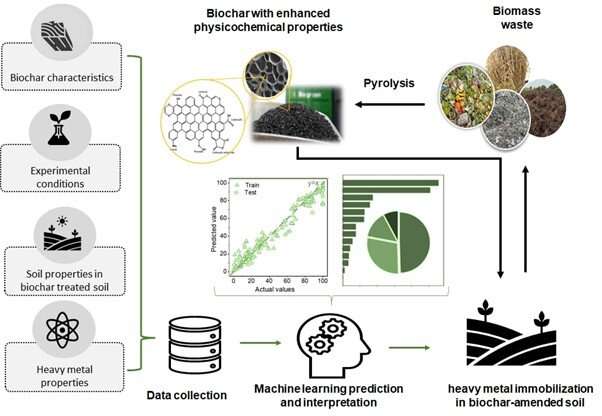Optimizing the mitigation of heavy metal pollution in biochar-treated soils with machine learning

Environmental pollution is one of the biggest global concerns of our time. Building a sustainable future is only possible if we proactively address every aspect of this problem. In this regard, soil pollution due to the accumulation of heavy metals (HMs) poses a serious threat to sustainable development as well as human health. This is because the HMs that enter the soil eventually find their way up the food chain, and upon entering the human body, can cause life-threatening diseases like cancer, renal failure, and cardiovascular disease. Minimizing HM concentration in soils is, therefore, a key goal in our fight against environmental pollution.
A notable development in this direction has been the use of "biochar"—biological waste decomposed thermally in absence of oxygen—to immobilize HM contaminants in the soil. Compared to raw feedstock, biochar can adsorb and immobilize HMs more efficiently owing to its unique physical and chemical properties. Moreover, it is highly adaptable and economically feasible, making it a promising alternative to fossil fuels.
There is, however, a catch: the HM immobilization efficiency in biochar-applied soils can vary depending on the type of soil, biochar, and HMs involved. In other words, the optimum conditions for maximum HM immobilization are extremely site-specific. Identifying these optimum conditions before applying biochar to the soil through a generalized empirical approach can reduce the cost and time involved in biochar remediation of soils. However, it is extremely difficult to optimize all the parameters involved simultaneously through experimentation.
An international research team led by Prof. Yong Sik Ok and Dr. Kumuduni N. Palansooriya from Korea University has now offered a solution—using machine learning (ML) to predict the HM immobilization efficiency for biochar-treated soils. In their study published in Environmental Science & Technology, the team developed three ML models, namely random forest, supporting vector regression, and neural network, to predict the immobilization efficiency based on biochar characteristics and production temperature, experimental conditions, soil properties, and HM properties.

Speaking about the motivation for pursuing an ML-based approach, Prof. Ok comments that "there has been a paucity of studies on ML-based prediction of biochar efficiency for immobilization of HM contaminants in soils due to the complex nature of biochar-soil interactions and a lack of systematic dataset. In our study, we wanted to address this gap."
They identified a total of 20 parameters as input features and used 152 data points to train the models for predicting the immobilization efficiency. Among the three models, random forest gave the most accurate predictions.
Among the input features, biochar nitrogen content and application rate were found to be the most important features in determining HM immobilization. Furthermore, soil properties and pH were found to be the third and fourth most important features, respectively, showing that soil properties had an important role to play as well. Additionally, a causal analysis estimate showed that the importance of properties in HM immobilization followed the order: biochar properties > experimental conditions > soil properties > HM properties.
With these illuminating findings, the team is excited about the future prospects of biochar in the application of HM immobilization. "Future research needs to focus on improving the ML-based approach by using a database based on studies with well-defined scientific objectives and similar methodologies under uniform experimental conditions," says Dr. Palansooriya. "With luck, biochar would offer us the chance to convert bioenergy into a carbon-negative industry."
More information: Kumuduni N. Palansooriya et al, Prediction of Soil Heavy Metal Immobilization by Biochar Using Machine Learning, Environmental Science & Technology (2022). DOI: 10.1021/acs.est.1c08302
Journal information: Environmental Science & Technology
Provided by Cactus Communications



















